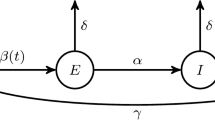Abstract
The research presented in this paper addresses the problem of fitting a mathematical model to epidemic data. We propose an implementation of the Landweber iteration to solve locally the arising parameter estimation problem. The epidemic models considered consist of suitable systems of ordinary differential equations. The results presented suggest that the inverse problem approach is a reliable method to solve the fitting problem. The predictive capabilities of this approach are demonstrated by comparing simulations based on estimation of parameters against real data sets for the case of recurrent epidemics caused by the respiratory syncytial virus in children.
Similar content being viewed by others
References
Alexander, M.E., Moghadas, S.M., 2004. Periodicity in an epidemic model with a generalized non-linear incidence. Math. Biosci. 189(1), 75–96.
Alexander, M.E., Moghadas, S.M., 2006. Bifurcation analysis of an SIRS epidemic model with generalized incidence. SIAM J. Appl. Math. 65(5), 1794–1816.
Alioum, A., Commenges, D., Thiebaut, R., Dabis, F., 2005. A multistate approach for estimating the incidence of human immunodeficiency virus by using data from a prevalent cohort study. J. R. Stat. Soc., Ser. C 54(4), 739–752.
Banks, H.T., Banks, J.E., Dick, L.K., Stark, J.D., 2007. Estimation of dynamic rate parameters in insect populations undergoing sublethal exposure to pesticides. Bull. Math. Biol. 69(7), 2139–2180.
Biegler, L.T., Grossmann, I.E., 2004. Retrospective on optimization. Comput. Chem. Eng. 28(8), 1169–1192.
Brunet, R.C., Struchiner, C.J., 1996. Rate estimation from prevalence information on a simple epidemiologic model for health interventions. Theor. Popul. Biol. 50(3), 209–226.
Capasso, V., Serio, G., 1978. A generalization of the kermack-mckendrick deterministic epidemic model. Math. Biosci. 42, 41–61.
Dhooge, A., Govaerts, W., Kuznetsov, Y.A., 2003. MATCONT: A MATLAB package for numerical bifurcation analysis of ODEs. ACM Trans. Math. Softw. (TOMS) 29(2), 141–164.
Gomes, M.G.M., Margheri, A., Medley, G.F., Rebelo, C., 2005. Dynamical behaviour of epidemiological models with sub-optimal immunity and nonlinear incidence. J. Math. Biol. 51(4), 414–430.
Greenhalgh, D., Moneim, I.A., 2003. SIRS epidemic model and simulations using different types of seasonal contact rate. Syst. Anal. Modell. Simul. 43(5), 573–600.
Hanke, M., Neubauer, A., Scherzer, O., 1995. A convergence analysis of the Landweber iteration for nonlinear ill-posed problems. Numer. Math. 72(1), 21–37.
Hethcote, H.W., van den Driessche, P., 1991. Some epidemiological models with nonlinear incidence. J. Math. Biol. 29(3), 271–287.
Hethcote, H.W., Lewis, M.A., van den Driessche, P., 1989. An epidemiological model with a delay and a nonlinear incidence rate. J. Math. Biol. 27(1), 49–64.
Korobeinikov, A., Maini, P.K., 2005. Non-linear incidence and stability of infectious disease models. Math. Med. Biol. 22(2), 113–128.
Kyrychko, Y.N., Blyuss, K.B., 2005. Global properties of a delayed SIR model with temporary immunity and nonlinear incidence rate. Nonlinear Anal.: Real World Appl. 6(3), 495–507.
Lagarias, J.C., Reeds, J.A., Wright, M.H., Wright, P.E., 1998. Convergence properties of the Nelder–Mead simplex method in low dimensions. SIAM J. Optim. 9(1), 112–147.
Li, M.Y., Muldowney, J.S., 1995. Global stability for the SEIR model in epidemiology. Math. Biosci. 125, 155–164.
Li, Z., Osborne, M.R., Prvan, T., 2005. Parameter estimation of ordinary differential equations. IMA J. Numer. Anal. 25(2), 264.
Pourabbas, E., d’Onofrio, A., Rafanelli, M., 2001. A method to estimate the incidence of communicable diseases under seasonal fluctuations with application to cholera. Appl. Math. Comput. 118(2–3), 161–174.
Ramsay, J.O., Hooker, G., Cao, C., Campbell, C., 2005. Estimating differential equations. Preprint, Department of Psychology, McGill University, Montreal, Canada, 40.
Ramsay, J.O., Hooker, G., Campbell, D., Cao, J., 2007. Parameter estimation for differential equations: a eneralized smoothing approach. J. R. Stat. Soc.: Ser. B (Stat. Methodol.) 69(5), 741–796.
Ruan, S., Wang, W., 2003. Dynamical behavior of an epidemic model with a nonlinear incidence rate. J. Differ. Equ. 188, 135–163.
van den Driessche, P., Watmough, J., 2000. A simple SIS epidemic model with a backward bifurcation. J. Math. Biol. 40(6), 525–540.
van den Driessche, P., Watmough, J., 2002. Reproduction numbers and sub-threshold endemic equilibria for compartmental models of disease transmission. Math. Biosci. 180(1–2), 29–48.
Wang, W., 2006. Epidemic models with nonlinear infection forces. Math. Biosci. Eng. 3(1), 267–279.
Weber, A., Weber, M., Milligan, P., 2001. Modeling epidemics caused by respiratory syncytial virus (RSV). Math. Biosci. 172(2), 95–113.
Xiao, D., Ruan, S., 2007. Global analysis of an epidemic model with nonmonotone incidence rate. Math. Biosci. 208(2), 419–429.
Author information
Authors and Affiliations
Corresponding author
Rights and permissions
About this article
Cite this article
Capistrán, M.A., Moreles, M.A. & Lara, B. Parameter Estimation of Some Epidemic Models. The Case of Recurrent Epidemics Caused by Respiratory Syncytial Virus. Bull. Math. Biol. 71, 1890–1901 (2009). https://doi.org/10.1007/s11538-009-9429-3
Received:
Accepted:
Published:
Issue Date:
DOI: https://doi.org/10.1007/s11538-009-9429-3




